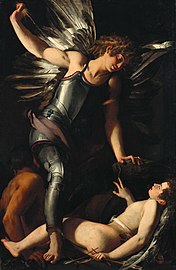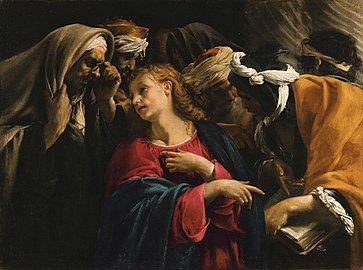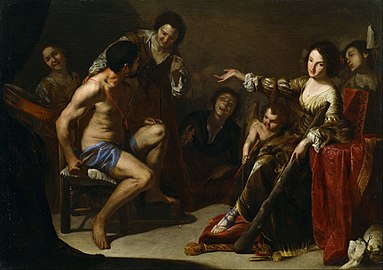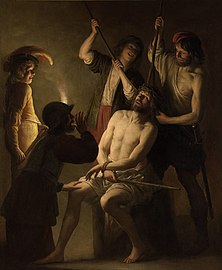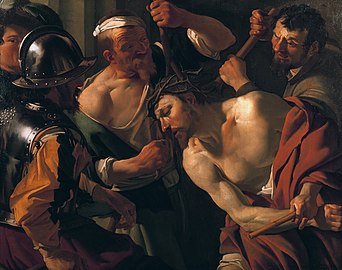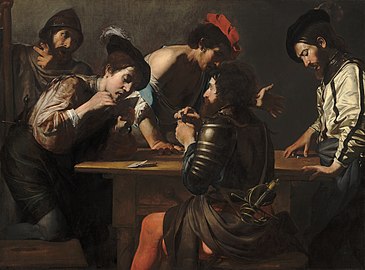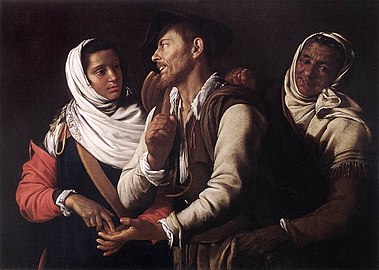Caravaggisti

The Caravaggisti (or the "Caravagesques") were stylistic followers of the late 16th-century Italian
Only in the 20th century was Caravaggio's importance to the development of Western art rediscovered. In the 1920s
Italian
Rome
At the height of his popularity in
- Selected works
-
Baglione – The Divine Eros Defeats the Earthly Eros, ca. 1602, Gemäldegalerie
-
Borgianni – Christ amongst the Doctors, ca. 1605–1610
-
Saraceni – Judith with the Head of Holophernes, 1610–1615, Kunsthistorisches Museum
-
Artemisia Gentileschi – Self-Portrait as a Lute Player, 1615–1617, Wadsworth Atheneum Museum of Art
-
Bartolomeo Cavarozzi – The Holy Family with Saint Catherine of Alexandria, 1618, Prado Museum
Naples
In May 1606 after the killing of Ranuccio Tomassoni, Caravaggio fled to Naples with a death sentence on his head.[6] While there he completed several commissions, two major ones being the Madonna of the Rosary, and The Seven Works of Mercy.[6] His work had a profound effect on the local artists and his brief stay in Naples produced a notable school of Neapolitan Caravaggisti, including Battistello Caracciolo, Bernardo Cavallino, Carlo Sellitto, Massimo Stanzione, Francesco Guarino, Mattia Preti, Andrea Vaccaro, Cesare Fracanzano and Antonio de Bellis. Giacinto Brandi was active mainly in Rome and Naples. The Caravaggisti movement there ended with a terrible outbreak of plague in 1656, but at the time Naples was a possession of Spain and the influence of Caravaggism had already spread there.
- Selected works
-
Caracciolo – Two youths with grapes, 1605–1610
-
Cavallino – Hercules and Omphale, c. 1640
-
Sellitto – Salome with the Head of St John the Baptist
-
Stanzione – Judith with the Head of Holofernes, c. 1640
-
Cesare Fracanzano – Drunken Silenus, c. 1630–1635
Northern Italy
Marco Antonio Bassetti is known to have been in Rome in 1616, and may have arrived there two years earlier. In Rome he came under the influence of the paintings of Caravaggio and Orazio Borgianni. On his return to Verona he painted a St. Peter and Saints for the church of San Tomaso and a Coronation of the Virgin for Sant' Anastasia. He died from the plague in Verona in 1630.
Italian painter
Central Italy
Pietro Ricchi (or il Lucchesino), born in Lucca, also often depicted brilliantly lit figures set against a dark background (see St. Sebastian).
Sicily
Mario Minniti was an Italian artist active in Sicily after 1606. He, at the age of 16, even posed for Caravaggio's painting Boy with a Basket of Fruit.
Flemish

Rubens was likely one of the first Flemish artists to be influenced by
Rubens' contemporary Abraham Janssens was another Flemish painter who travelled to Italy (from 1597 to 1602) where he became acquainted with the work of Caravaggio. His work after his return to Antwerp shows the influence of Caravaggio. The composition Scaldis and Antwerpia of 1609 derives its expressive power from the use of strong contrasts of light and shadow (chiaroscuro) as was pioneered by Caravaggio.[9]
It is mainly the Flemish artists from the generation after Rubens coming on the art scene in the 1620s who were most influenced by Caravaggio. It can even be said that there was a Caravaggist craze in Flanders from about 1620 to 1640.[10] The artists are often referred to as the Ghent Caravaggisti and the Antwerp Caravaggisti after the city in which they were principally active. There is, however, no discernible stylistic distinction between these two movements other than individual ones. Among the Ghent Caravaggisti can be listed Jan Janssens, Melchior de la Mars and Antoon van den Heuvel. The list of Antwerp Caravaggisti is significantly longer reflecting the importance of this city as the pre-eminent artistic centre of Flanders. They include Theodoor Rombouts, Gerard Seghers, Jan Cossiers, Adam de Coster, Jacques de l'Ange and Jan van Dalen. In Bruges, Jacob van Oost painted genre and history paintings showing the influence of the work of Caravaggio and Manfredi whose work he had studied in Rome.[11] Some Flemish Caravaggisti left their homeland for Italy where they were influenced by the work of Caravaggio and his followers and never returned home. This is the case of Louis Finson of Bruges who after stays in Naples and Rome spent most of his career in France.[12] Another example of an expatriate Flemish Caravaggist is Hendrick de Somer of Lokeren or Lochristi who spent most of his life and career in Naples where he painted in a Caraviggist style influenced by the Spanish painter Jusepe de Ribera.[13]
What most of these artists shared in common is that they likely visited Italy where they had first-hand contact with the work of Caravaggio or his Italian and Dutch followers. The influence of Caravaggio and his followers on their work can be seen in the use of dramatic light effects and expressive gestures as well as the new subject matter such as card sharps, fortune tellers, the denial of St Peter, etc.[10][14][15] Some of the artists focused on certain aspects of Caravaggio's oeuvre. For instance, Adam de Coster was referred to as the Pictor Noctium (painter of the nights) because of his preference for the use of stark chiaroscuro and the repeated motif of half-length figures illuminated by a candle which is covered.[16]
Many of these artists such as Rombouts, Cossiers and Seghers later abandoned their strict adherence to the Caravaggist style and subject matter and struck out in different directions often under the influence of the older generation of Flemish artists who had such a dominant influence on Flemish art in the 17th century, i.e. Rubens and van Dyck.[10][15]
- Selected works
-
De Coster – A Man Singing by Candlelight, 1620
-
Rombouts – The Lute player, 1620
-
Seghers – The Denial of St. Peter, c. 1623
-
Jan Janssens – The Crowning with Thorns, c. 1648–1650
-
Van Oost, The calling of St. Matthew, 1641
Dutch
In the first three decades of the 17th century, some Catholic artists from the city of Utrecht in the
- Selected works
-
Van Baburen – Christ with the crown of thorns, 1623
-
Van Honthorst – Merry Company, 1623
-
Van Bijlert – The calling of St. Matthew, 1625-1630
-
Ter Brugghen – The Duet, 1628
French
One of the first
- Selected works
-
Bigot – Judith and Holofernes
-
Boulogne – The Cheats, 1618–1620
-
La Tour – The Fortune Teller, 1630
-
Vouet – The Fortune Teller, 1617
-
de Boulogne – Lute Player, 1626
Spanish
- Selected works
-
Ribalta – Christ with the Cross, 1612
-
Velázquez – Old Woman Frying Eggs (The Old Cook), 1618
-
Zurbarán – The Martyrdom of Saint Serapion, 1628
-
Murillo - The Virgin of the Rosary, c. 1650–1655
See also
- Caravaggio
- Paintings from the Contarelli chapel
References
- ISBN 0-375-50801-5.
- ^ Roberto Longhi, quoted in Lambert, op. cit., p.15
- ^ Bernard Berenson, in Lambert, op. cit., p.8
- ^ Museo del Prado, Enciclopedia - Voz: Cavarozzi, Bartolomeo. Accessed 3 December 2022
- ^ J. Paul Getty Museum: Bartolomeo Cavarozzi. Accessed 3 December 2022
- ^ ISBN 0-7148-3966-3.
- ^ Sirjacobs, Raymond. Antwerpen Sint-Pauluskerk: Rubens En De Mysteries Van De Rozenkrans = Rubens Et Les Mystères Du Rosaire = Rubens and the Mysteries of the Rosary, Antwerpen: Sint-Paulusvrienden, 2004
- ^ Gregori, Mina, Luigi Salerno, and Richard E. Spear, The Age of Caravaggio, Metropolitan Museum of Art, 1985
- ^ Roger A. d'Hulst, Abraham Janssens - Scaldis en Antwerpia Archived 2020-10-23 at the Wayback Machine at Openbaar Kunstbezit Vlaanderen (in Dutch)
- ^ a b c "Matthias Depoorter, Theodoor Rombouts on Baroque in the Southern Netherlands". Retrieved 2019-07-31.
- ^ Hans Vlieghe. "Oost, Jacob van, I." Grove Art Online. Oxford Art Online. Oxford University Press. Web. 3 August 2019
- ^ Louis Finson at the Netherlands Institute for Art History (in Dutch)
- ^ Damian, Veronique et Chiara Naldi, Massimo Stanzione, Guercino, Hendrick de Somer et Fra' Galgario, Paris: Galerie Canesso, 2016, p. 20-25
- ^ "Matthias Depoorter, Jan Janssens on Baroque in the Southern Netherlands". Retrieved 2019-07-31.
- ^ a b "Matthias Depoorter, Gerard Seghers on Baroque in the Southern Netherlands". Retrieved 2019-07-31.
- ^ Adam de Coster, The Denial of Saint Peter at Sotheby's
- ^ [https://www.rijksmuseum.nl/en/rijksstudio/styles/caravaggism Caravaggism at the Rijksmuseum
- ^ Brejon de Lavergnée, Barbara. 'Simon Vouet', Oxford Art Online.
- ^ Anthony Blunt, "Art and Architecture in France, 1500–1700", 1953, Penguin
External links
- Figures of reality. French Caravaggisti, Georges de La Tour, the Le Nain brothers Archived 2020-09-27 at the Wayback Machine
- Orazio and Artemisia Gentileschi, a fully digitized exhibition catalog from The Metropolitan Museum of Art Libraries, which contains material on Caravaggisti (see index)
- Zurbarán, an exhibition catalog from The Metropolitan Museum of Art (fully available online as PDF), which contains material on Caravaggisti (see index)
- Jusepe de Ribera, 1591-1652, an exhibition catalog from The Metropolitan Museum of Art (fully available online as PDF), which contains material on Caravaggisti (see index)

